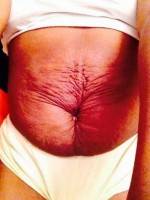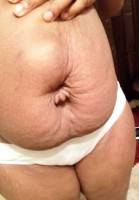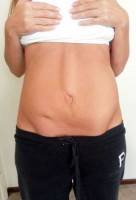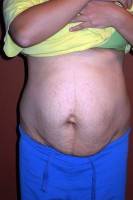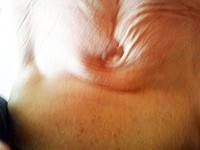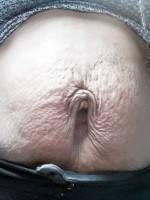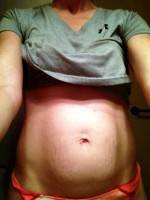Tummy tuck muscle repair
The muscle wall repair portion of the tummy tuck helps give excellent contour to the abdomen. Generally, this repair is accomplished with very strong sutures that are placed in two layers.
While it is possible to “pop” these sutures, it would take a very significant force. At 2 1/2 weeks after surgery, the chance of ruining the repair are higher since the muscle wall repair has not reached full strength.
If you notice a new bulges or changes in your contour, the repair may have be disrupted. The best thing to do is discuss the issue with your plastic surgeon. (Naveen Setty, MD, Dallas Plastic Surgeon)
Abdominoplasty not only removes excess skin, but also tightens the underlying abdominal wall muscles. These muscles can be weakened, stretched, and torn during pregnancy.
This can result in the characteristic protuberant abdomen that is commonly seen following pregnancy. Abdominoplasty tightens these muscles in a side to side manner which results in a flatter abdomen.
Most surgeons use a continuous suture for this closure, but in some cases individual sutures may be used instead. These sutures maintain the structural integrity of the abdominal wall until the wound has regained adequate strength.
This usually occurs in about 6 to 8 weeks. At this point, these structural sutures have served their purpose. When trauma of any type occurs during the initial phases of wound healing, disruption of these sutures can result in a recurrence of the original problem. Under these circumstances a flat abdominal wall may suddenly bulge in an outward direction.
If you’re concerned about disruption of your internal sutures, consultation with your plastic surgeon is appropriate. Your surgeon should be able to evaluate your abdominal wall and determine whether or not a disruption of your closure has occurred. (Richard J. Bruneteau, MD, Omaha Plastic Surgeon)
It is possible to have damaged or popped internal sutures if you have a significant fall only 2 1/2 weeks after a tummy tuck. The best thing to do is to see your plastic surgeon so that they may thoroughly examine you. Your plastic surgeon will look for bulges that may not present before and for asymmetry or differences between one side of your admin and the other.
Depending on the technique that your plastic surgeon used, your muscle repair may have been done in multiple layers which could limit the damage from such a fall. (Pat Pazmino, MD, Miami Plastic Surgeon)
With an abdominoplasty, the fascia surrounding the rectus muscles that run vertically on your abdomen is brought together in the midline to narrow the waist and improve the overall contour that is typically affected by pregancies. At 2 1/2 weeks the repair is not healed sufficient for vigorous exercise (typically at leat 6 weeks) and any significant abdominal straining should be avoided.
Sorry that you fell on your back and I’m sure it hurts alot, but feeling a pain in the surgical area may simply mean that you strained an area that is still sore from surgery and not likely that you disrupted the repair. You should discuss your concern with your plastic surgeon at your next visit or sooner if your symptoms worsen or if you notice any visible changes. (David J. Levens, MD, Coral Springs Plastic Surgeon)
A fall at 2-1/2 weeks after an abdominoplasty is going to give you pain regardless. Although unlikely, it is possible to either have your plication suture pull through or rupture. As stated by others, there are usually a few layers of sutures for built in redundancy.
I would contact your surgeon for an exam and continue wearing the postoperative garment you were given. (David Bogue, MD, Boca Raton Plastic Surgeon)
It would be tough for you to really cause a problem after surgery. Most often times people describe hearing a pop or feeling the actual suture rupture. (Christopher V. Pelletiere, MD, Barrington Plastic Surgeon)
The internal sutures are very strong and some of us put two layers so that if one layer fails the other will hold. At 21/2 weeks, you are still vulnerable and you should be seen by your plastic surgeon for evaluation and follow up. Only time will tell if you have ripped the sutures enough to require another surgery for repair. (Samir Shureih, MD, Baltimore Plastic Surgeon)
Tear of internal tummy tuck sutures creates a pop and usually a visible bulge in the abdomen
Obviously you need to be examined by your doctor. However if in fact the muscle repair sutures were torn or broken, it is most likely that you would know. If this occurs the patient most likely feels a pop as the suture is broken. in addition, if the suture repair fails, a noticeable bulge is seen in the abdomen where the lax muscles give way. (Brooke R. Seckel, MD, FACS, San Antonio Plastic Surgeon)
You may have harmed your muscle sutures, but it will take months to determine if that happened. If there is persistent bulging after 6 months, you probably tore something. (Gary Lawton, MD, FACS, Omaha Plastic Surgeon)
Stitches & Tummy Tucks
A full tummy tuck requires an incision from one hip to the other. This incision is carried through the skin and fat down to the underlying muscle layer. The muscle layer is not entered. The skin and fat layer is lifted off of the muscle layer up to the belly button. When the belly button is reached, an incision is made around the belly button, allowing the skin and fat layer to be lifted off of the muscle layer up to the rib cage.
At this point, the entire muscle layer is well visualized. Normally, stitches are placed in the muscle layer to tighten it up.Some surgeons place individual sutures along this line from the rib cage down to the pubic bone. Some surgeons utilize one continuous running stitch along this line. Some surgeons may actually place two rows of running stitches along this line. After a tummy tuck, situations that may stress this repair can occur. Nausea and vomiting can create significant pressure along this suture line. Chronic coughing after surgery can also stress this area. Other activities that cause tensing of the abdominal wall could further jeopardize this repair. If individual sutures were placed and some of them individually break, then a bulge may appear in that particular area.
On occasion, patients actually report hearing a popping sound when this occurs. If one continuous stitch is placed from the rib cage down to the pubic bone and it breaks, then the muscle repair is lost but usually there are no areas of localized bulging. It is very important after an abdominoplasty to follow the postoperative instructions given to you by your surgeon to help protect your repair. (John J. Edney, MD)
Fall after Tummy Tuck
Your surgeon should follow you closely over the next several months and advise you on abdominal support and limitations of physical activities. If you have done anything serious it usually would be evident fairly soon, but there may be some changes later. As he monitors you he can reassure you that everything is healing nicely or that there has been some rupture of sutures and he can recommend how to proceed from there. Most damage should however be apparent within days of the fall and if you have weathered the situation this far you should be fine. (Theodore Katz, MD, FACS, Philadelphia Plastic Surgeon)
Suture tears in tummy tuck
Tummy tuck sutures that are internal are susceptible to tearing. If you are worried about a possible tear of your plication, you should see your surgeon (Steven Wallach, MD, Manhattan Plastic Surgeon)
